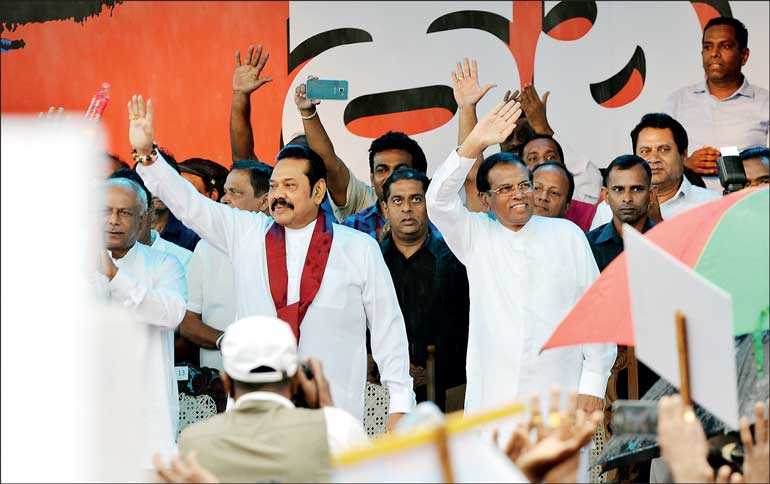Tuesday Apr 15, 2025
Tuesday Apr 15, 2025
Wednesday, 17 April 2019 00:00 - - {{hitsCtrl.values.hits}}

The process of constitutional reforms is stalled. This has happened some time back. To say precisely, it was limping from the very beginning. The reason for this was that the politicians of this country placed their own political interests ahead of the national interest. 
The President before and after occupying the post stated that he would be a one-term president. All expected that he would work as a non-partisan president. The situation changed gradually after he took over the leadership of the Sri Lanka Freedom Party (SLFP). The 19th Amendment to the Constitution was passed with several amendments which were not originally planned, at which point the President’s support for the constitutional change was crucial. His leadership of the SLFP helped the process a lot.
The rift between the President and the Prime Minister emerged during the 100-day period of the Interim Government. This affected the balance of the National Government and the situation came to the zenith in October 2018. It was declared by the Prime Minister well ahead of the General Election the continuity of the National Government. He termed it as Licchavi system.
Events that happened during the General Election and thereafter led to the situation in which the leadership of the President to the SLFP would hinder the very purpose of the National Government. The SLFP considered him a traitor. A vast majority of the SLFP voted against him at the Presidential Election. Therefore, he could not effectively lead the party.
Mahinda Rajapaksa gave the leadership to the election campaign of the SLFP at the General Election. The President had given nominations to Rajapaksa since he was compelled to do so. That act was criticised by many who voted in favour of the President at the Presidential Election.
Factions of the SLFP joined the National Government before and after the general election. Later some of them who joined the National Government defected. The faction which did not join the National Government treated the President as an opponent. Therefore, from the beginning the National Government did not evolve as a national government.
MPs of the SLFP who were in the National Government gave attention to the requirements of their colleagues who were in the Opposition. This background degraded the National Government to the level of a coalition government since there was a strong Opposition, which was a faction of one of the constituent parties of the Government. The main reason for this was the leadership of the President of the SLFP.
The President tried to walk a tightrope, but he failed. In his controversial address to the nation just prior to the General Election, he said even if the SLFP wins he would not give the prime minister post to Rajapaksa and in the same speech he said if Parliament was dissolved soon after the Presidential Election, the UNP would have a landslide victory, hence he prevented it.
Public mandate was by and large for the UNP. After the Presidential Election the exodus of MPs from the SLFP to the UNP was prevented by the Licchavi system and the acceptance of SLFP leadership by the President. Sri Lanka had minority governments except in two instances after the elections held under the 1978 Constitution. The UNP accommodated SLFP ministers, some of them were rejected by the voters and appointed through the National List. As a result, voters of the UNP were confused at the electorate level since the power was not transferred yet.
One main reason for not dissolving Parliament soon after the Presidential Election was that the issue of the pension rights of the MPs. This symbolises the situation the country is in. If the President was neutral and Mahinda Rajapaksa joined the National Government in the capacity of Leader of the Opposition, then that would have been a real national government and not a coalition government. The functions of that government would have been to establish a new constitution and thereby give a permanent solution to the ethnic problem of the country and formulate long-lasting national policies for the country. Thereafter the national government would have been dissolved.
Under these circumstances the court cases against Mahinda Rajapaksa and his family members would have been in the same situation as of now. Therefore, in the national point of view the nation has paid the price already but not achieved any result. If the price was paid to achieve the said envisaged objectives of the National Government, there would have been no issue. However, the price paid has granted petty political gains to the Prime Minister and the President. Split of the SLFP was a gain to the Prime Minister and eventually by combining it the President tried to gain politically.
The President would have thought of a political base for himself when accepting the leadership of the SLFP. He argued in favour of his decision that if not for him the Parliament would have not been able to pass the 19th Amendment to the Constitution. There was a considerable influence made by him for the process. On the other hand, it was a minority government and the Opposition did not want to topple the apple cart. For the Opposition if not consented there was a risk of facing a general election and losing more seats. In the long run the neutrality of the President would have been the best to achieve the given objectives of the National Government.
Even under the given circumstances the Public Representations Committee on Constitutional Reform headed by Lal Wijenayake was established and the report was issued; the Parliament met as a constitutional assembly with the powers of Parliamentary Select Committee to draft the new constitution; Steering Committee of the Constitutional Assembly was appointed with 21 MPs; six sub committees of the Steering Committee were established with the active participation of MPs representing all the political parties of the Parliament and those reports were published; based on the steering committee deliberations and reports of the sub committees, an expert panel prepared a report to the steering committee in the form of a draft constitution; and it was presented to the Constitutional Assembly by the Steering Committee.
It may have been the intention of the Prime Minister to take the debate of the Constitution to the people with the political leadership of the President. The President as well as the Prime Minister were reluctant to give the political leadership to the process in the circumstances of existing Coalition Government instead of the expected National Government. In fact, the President would have been able to give the political leadership to the process if he intended to serve one term and if he was neutral.
Under the prevailed political situation, when there was a strong political group in the Opposition, highest echelons of the Sangha community of the country expressed views that a new constitution was not necessary for the country. Truth was that election manifestos of Sri Lanka for decades were filled with the promises of abolishing the executive presidency. Although their view was politically motivated and reactionary in essence, the President and the Prime Minister kept mum over the issue.
In this situation it is not possible either to establish a new constitution or to give a solution to the ethnic problem of this country. Ethnocentric elements in the country believe that the ethnic problem of the country was over with the ending of the war. At the end of the war when Prabhakaran and his colleagues were killed, along with the sigh of relief that the war was over the political balance of power was readjusted unfavourably to the Tamils.
At the time of the war Sri Lankan leaders were prepared to give a federal solution to the problem and after ending the war they said that a solution of 13+ can be given which meant most probably a second chamber as proposed by the new draft constitution. After losing the power of the barrel of the gun, Tamils failed to achieve their objectives through the democratic process as happened in previous instances prior to the war since Sri Lankan democracy means dictatorship of the majority.
In relation to divided ethno-religious groups, Sri Lanka is a country which depends on a limited backward population and which is run by a set of opportunist politicians. Most of the countries in the world are like this. Some powerful leaders of some of the countries openly challenged the backward thinking in relation to ethnocentrism of their respective populations. Mahatma Gandhi and Nelson Mandela were prominent examples. Some leaders such as Lee Kuan Yew took the country forward based on their political power.
Out of the leaders of this country Mahinda Rajapaksa soon after ending the war and Maithripala Sirisena after coming to power in 2015 got this opportunity to rise to the level of Gandhi, Mandela or Lee but they have selected the dustbin of the history instead of immense prestige, due to greediness to personal and petty political gains.
To place the country in the path of nation building there should be a strong apolitical people’s movement comprising of fair-minded people of all ethnicities and followers of all religions, rather than depending on the politicians for that task.
Discover Kapruka, the leading online shopping platform in Sri Lanka, where you can conveniently send Gifts and Flowers to your loved ones for any event including Valentine ’s Day. Explore a wide range of popular Shopping Categories on Kapruka, including Toys, Groceries, Electronics, Birthday Cakes, Fruits, Chocolates, Flower Bouquets, Clothing, Watches, Lingerie, Gift Sets and Jewellery. Also if you’re interested in selling with Kapruka, Partner Central by Kapruka is the best solution to start with. Moreover, through Kapruka Global Shop, you can also enjoy the convenience of purchasing products from renowned platforms like Amazon and eBay and have them delivered to Sri Lanka.
Discover Kapruka, the leading online shopping platform in Sri Lanka, where you can conveniently send Gifts and Flowers to your loved ones for any event including Valentine ’s Day. Explore a wide range of popular Shopping Categories on Kapruka, including Toys, Groceries, Electronics, Birthday Cakes, Fruits, Chocolates, Flower Bouquets, Clothing, Watches, Lingerie, Gift Sets and Jewellery. Also if you’re interested in selling with Kapruka, Partner Central by Kapruka is the best solution to start with. Moreover, through Kapruka Global Shop, you can also enjoy the convenience of purchasing products from renowned platforms like Amazon and eBay and have them delivered to Sri Lanka.